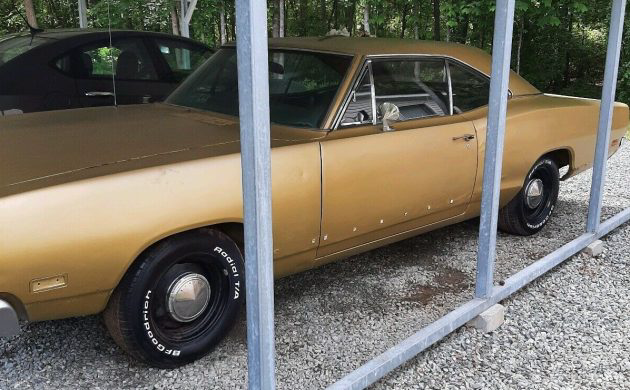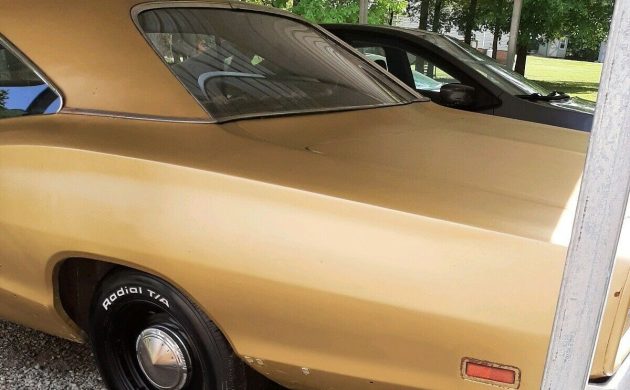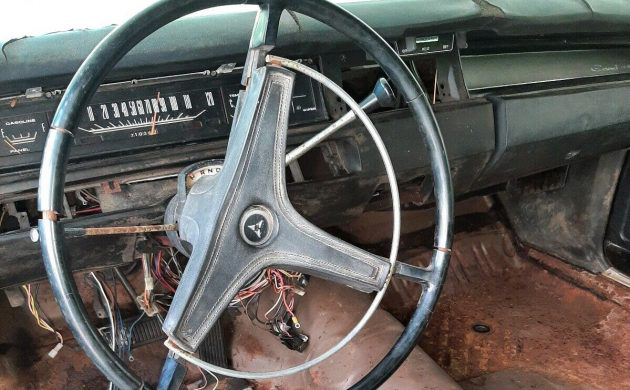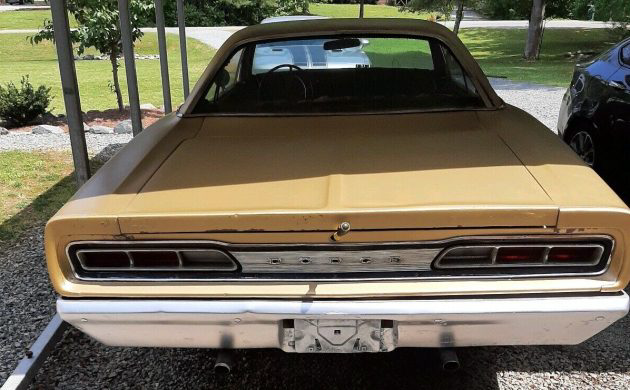I remember a time years ago when I knew a bit about cars and engines, and when I glimpsed an ordinary-looking Dodge Coronet 440, such as this 1969 example, I thought “An engine that big in such a non-remarkable looking car?” Wow, just think how a Coronet 500 must haul you know what. Well, it was obviously a learning exercise that I still find confusing today. A Coronet R/T has a 440 CI engine but a Coronet 440 doesn’t? OK, whatever. Automotive marketing is one of those things that sometimes makes perfect sense and then other times, well, not so much. With all of that out of the way let’s examine this ’69 Coronet 440 and find out what, if anything, is special about it. It’s located in Graham, North Carolina and is available, here on eBay for a current bid of $7,500 with just one bid tendered.
The line-up for ’69 had the Coronet DeLuxe at the bottom, the 440 on the next rung, the duded-up 500 perched above both of those, and the performance-oriented R/T riding in the top slot. There was also a budget hot rod version, similar to Plymouth’s Road Runner and known as the Super Bee. As for body styles, the 440 came in two-door coupes and hardtops, along with a four-door sedan and a station wagon. Old Ride states that a little over 200K Coronets saw the light of day in ’69 with the 440 trim level making up about half of that total. Yes, they were popular, but baring the Super Bee, R/T, or the closely related Charger, you hardly ever stumble across one of these less exalted trim levels today.
The listing on this one is confusing as it states, “comes with a running early 70s Cuda 318 and trains (sp)…Original drivetrain is in car…Comes with a running 318 and trans. out of a Cuda…Cuda Engine is on my trailer, so it would be easy to transfer it to your trailer…Engine turns. But needs carb. Distributor and valve covers”. This was originally a 230 gross HP, 318 CI V8 powered Dodge. And that’s what appears to be under the hood, though it has been modified with a four-barrel carburetor intake manifold. As it is, it’s definitely not a runner but perhaps there is a second engine, the one on the trailer, that is. As is almost always the case, a TorqueFlite three-speed automatic transmission handles all things gear-related.
It’s safe to say, based on the C-pillar molding, that this Coronet originally had a vinyl roof covering. Fortunately, what can be seen of the roof panel shows it as undamaged by the effects of trapped moisture and the resulting rust that is manifested. The seller adds, “Floor pans have surface rust but not rusted through…Pretty solid body for a restoration…This needs total restoration. Only rust on bottom side of hood and trunk lid. The trunk needs a new pan”. OK, it’s going to need an up-close and personal inspection to figure out what’s what.
The interior is pretty shaky looking as there’s no front seat, under dash switch panel, or headliner, and the dash pad is done. I get nervous and jerky when I see a tangle of under dash wires though we are told, “All wires shown under dash are perfect with connectors. No wires are cut“.
This Dodge is a no reserve bid but I’m thinking the single opening bid that has been tendered is a shill designed to get at least $7,500 – but I don’t know that with accuracy, it’s just an assumption. If you want to build a late ’60s Mopar hotrod, this example is probably as good as any, especially considering these B-bodies’ tendency to disappear into a pile of cinders – this car actually looks reasonable. What do you think, a worthwhile project?








A Dodge 440 could be ordered with the slant-six as a matter of fact. The only difference between a 440 and the bottom of the line Deluxe was the 440 had color-keyed interior.
The Intake manifold appears to be a stock 4bbl manifold on the “318.” I thought the 318 LA Motor only came in 2 BBL form or am I mistaken?
The 318 came with a 4bbl but not until 1981 when it replaced the E58 360 4bbl engine as the top police car option. They had Carter Thermoquad carbs through 1984 and, beginning in 1985, were equipped with Rochester Qudrajets, after Carter went belly-up in ’84. Some Dodge pickups also got Quadrajets in the mid-late ’80’s.
The intake you see on this engine is, likely, from a 340, 360HP, or 81-later 318 Police engine. All were spreadbore, like this one, regardless.
Thank you, I had forgotten that!
If it is an 80’s motor it is unfortunately a low compression wheezing cast iron anchor. 340? One of my favorite Mopar engines. Can a deck job boost compression or would one need bigger pistons? Just curious, seen a few dusters locally with 318’s.
If that’s a 318, why are the plug wires and cap at the front of the engine?
Tod Fairchild, liegt bloß so drauf .
Es ist ein Small Block , zu erkennen am Bypass .